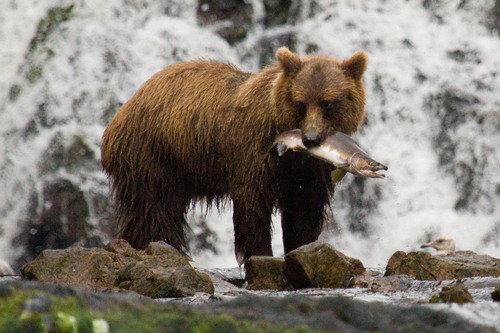
Brown Bear
Ursus arctos, the majestic brown bear, thrives in diverse habitats from dense forests to alpine meadows. With a mighty physique and a keen omnivorous diet, it shapes ecosystems by dispersing seeds and preying on various species. Intriguingly, it exhibits solitary yet complex social interactions.
20-30 years
Lifespan
136.0 - 390.0 kg
Weight
Height: 1.5 - 2.8 m
Size
Brown, Black, Tan
Color
35 mph
Top Speed
Least Concern
Conservation Status
Stable
Population Trend
Characteristics
The Ursus arctos, commonly known as the brown bear, is a large bear species found across North America, Europe, and Asia. Recognizable by its powerful build, thick fur, and distinctive hump over the shoulders, it is an omnivorous creature with a varied diet that includes fish, berries, and small mammals. Brown bears are solitary but notable for their complex social behaviors during feeding and mating seasons. They play a crucial role in their ecosystem by dispersing seeds and maintaining the balance of their habitats.
Distribution Range of the Brown Bear
Ursus arctos, commonly known as the brown bear, is native to a wide range of regions across the Northern Hemisphere. Its geographical distribution includes North America (primarily in Alaska and western Canada), Europe (spanning from Scandinavia to Eastern Europe), and Asia (including parts of Russia, China, and Japan).
Brown Bear's Habitat
Environmental Conditions
Brown bears inhabit a diverse array of environments, typically preferring areas with dense forest cover, mountainous regions, and tundra ecosystems. They require habitats that provide sufficient food resources and denning sites. The climate in these regions can range from temperate to subarctic, with significant seasonal variations.
Ecological Niche
As omnivores, brown bears occupy a versatile ecological niche. They are adept at exploiting a wide range of food sources, including fruits, nuts, roots, insects, fish, and small to large mammals. Their role as apex predators and scavengers influences the ecological balance by controlling prey populations and aiding in nutrient distribution. Regional adaptations may include variations in diet and hibernation behaviors, influenced by local environmental conditions and food availability.
Copyright @ Nature Style Limited. All Rights Reserved.
 English
English